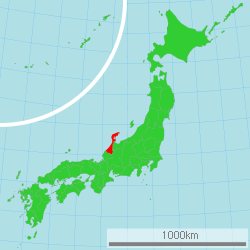Ishikawa Prefecture
|
Ishikawa Prefecture 石川県 |
|||
|---|---|---|---|
| Prefecture | |||
| Japanese transcription(s) | |||
| • Japanese | 石川県 | ||
| • Rōmaji | Ishikawa-ken | ||
|
|||
 |
|||
| Country | Japan | ||
| Region |
Chūbu Hokuriku |
||
| Island | Honshū | ||
| Capital | Kanazawa | ||
| Government | |||
| • Governor | Masanori Tanimoto | ||
| Area | |||
| • Total | 4,185.22 km2 (1,615.92 sq mi) | ||
| Area rank | 35th | ||
| Population (February 1, 2011) | |||
| • Total | 1,168,929 | ||
| • Rank | 34th | ||
| • Density | 279.30/km2 (723.4/sq mi) | ||
| ISO 3166 code | JP-17 | ||
| Districts | 5 | ||
| Municipalities | 19 | ||
| Flower | Black lily (Fritillaria camtschatcensis) | ||
| Tree | Hiba (Thujopsis dolabrata) | ||
| Bird | Golden eagle (Aquila chrysaetos) | ||
| Website | [1] | ||
Ishikawa Prefecture (石川県 Ishikawa-ken?) is a prefecture of Japan located in the Chūbu region on Honshū island. The capital is Kanazawa.
Ishikawa was formed in 1872 from the merger of Kaga Province and the smaller Noto Province.
Ishikawa is on the Sea of Japan coast. The northern part of the prefecture consists of the narrow Noto Peninsula, while the southern part is wider and consists mostly of mountains with the prefecture's chief city, Kanazawa, located in the coastal plain. The prefecture also has some islands, including Notojima, Mitsukejima, Hegurajima.
As of April 1, 2012, 13% of the total land area of the prefecture was designated as Natural Parks, namely the Hakusan National Park; Echizen-Kaga Kaigan and Noto Hantō Quasi-National Parks; and five Prefectural Natural Parks.
Eleven cities are located in Ishikawa Prefecture:
These are the towns in each district:
Ishikawa's industry is dominated by the textile industry, particularly artificial fabrics, and the machine industry, particularly construction machinery.
...
Wikipedia


